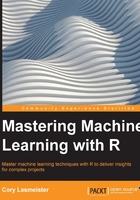
What this book covers
Chapter 1, A Process for Success - shows that machine learning is more than just writing code. In order for your efforts to achieve a lasting change in the industry, a proven process will be presented that will set you up for success.
Chapter 2, Linear Regression - The Blocking and Tackling of Machine Learning, provides you with a solid foundation before learning advanced methods such as Support Vector Machines and Gradient Boosting. No more solid foundation exists than the least squares linear regression.
Chapter 3, Logistic Regression and Discriminant Analysis, presents a discussion on how logistic regression and discriminant analysis is used in order to predict a categorical outcome.
Chapter 4, Advanced Feature Selection in Linear Models, shows regularization techniques to help improve the predictive ability and interpretability as feature selection is a critical and often extremely challenging component of machine learning.
Chapter 5, More Classification Techniques – K-Nearest Neighbors and Support Vector Machines, begins the exploration of the more advanced and nonlinear techniques. The real power of machine learning will be unveiled.
Chapter 6, Classification and Regression Trees, offers some of the most powerful predictive abilities of all the machine learning techniques, especially for classification problems. Single decision trees will be discussed along with the more advanced random forests and boosted trees.
Chapter 7, Neural Networks, shows some of the most exciting machine learning methods currently used. Inspired by how the brain works, neural networks and their more recent and advanced offshoot, Deep Learning, will be put to the test.
Chapter 8, Cluster Analysis, covers unsupervised learning. Instead of trying to make a prediction, the goal will focus on uncovering the latent structure of observations. Three clustering methods will be discussed: hierarchical, k-means, and partitioning around medoids.
Chapter 9, Principal Components Analysis, continues the examination of unsupervised learning with principal components analysis, which is used to uncover the latent structure of the features. Once this is done, the new features will be used in a supervised learning exercise.
Chapter 10, Market Basket Analysis and Recommendation Engines, presents the techniques that are used to increase sales, detect fraud, and improve health. You will learn about market basket analysis of purchasing habits at a grocery store and then dig into building a recommendation engine on website reviews.
Chapter 11, Time Series and Causality, discusses univariate forecast models, bivariate regression, and Granger causality models, including an analysis of carbon emissions and climate change.
Chapter 12, Text Mining, demonstrates a framework for quantitative text mining and the building of topic models. Along with time series, the world of data contains vast volumes of data in a textual format. With so much data as text, it is critically important to understand how to manipulate, code, and analyze the data in order to provide meaningful insights.
R Fundamentals, shows the syntax functions and capabilities of R. R can have a steep learning curve, but once you learn it, you will realize just how powerful it is for data preparation and machine learning.